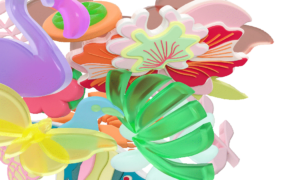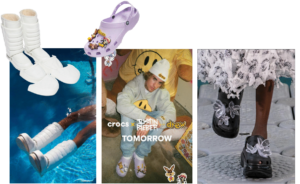Audience Analysis
The core audience groups of Kat Maconie were defined by analyzing the data provided by the brand, and conducting online interviews with some of its fans. They are young, fashion-conscious women who are confident in their own taste and style, and like to express their unique personality with their fashion choices. This audience group is consistent with the target market of Kat Maconie, which is described as “a generation of women who champion their individuality”.


Inspiration and Design
The inspiration for Kat Maconism came from Crocs shoes, which have breathable holes on the upper that give consumers a space for secondary creation. Crocs shoes can be DIY designed through decorative buckles, which have attracted a large number of fans to customize their own shoes and share them on social media.
The DIY of Crocs shoes not only greatly improves the aesthetic appeal of the shoes, but also the bright colors and funny shapes of the shoes make the brand gain more attention. According to a report by Business Insider, Crocs shoes have become a “pandemic-proof” trend, with sales increasing by 12% in 2020 and celebrities endorsing the brand.

Interactive Installation
Consumers fill in a questionnaire in which 10 simple questions are set. The questions are about the consumer’s personality, habits and intuition. According to research in color psychology, different colors evoke different psychological feelings and the results will affect various areas such as clothing, food, housing and transport. For example, red is associated with passion, excitement, and energy, while blue is linked to calmness, trust, and intelligence.
Color Test
The dominant color of the player’s personality is revealed by the installation based on the answers to the quiz game. Color is a subjective response and behavior, but also an objective stimulus and symbol for consumers, which will inspire them to create more user-generated content (UGC) on the internet. UGC is a valuable asset for brands, as it can increase brand awareness, customer loyalty, and social proof. For example, Kat Maconie encourages its customers to share their photos with the hashtag #katgirls / #katboys on Instagram, and features some of them on its official account.

Recommendation System
The installation automatically analyzes consumers’ consumption habits and scenarios by understanding their consumer behavior, and recommends suitable heels and accessories, which are all removable and interchangeable. The recommendation system is based on a machine learning algorithm that uses data from previous customers’ purchases, preferences, and feedback to generate personalized suggestions. This can enhance the customer experience, increase the conversion rate, and reduce the return rate.
DIY Station
Consumers can install 3D-printed heels and accessories on their shoes for DIY creation at the DIY station. The 3D-printing technology allows for more flexibility, customization, and innovation.
